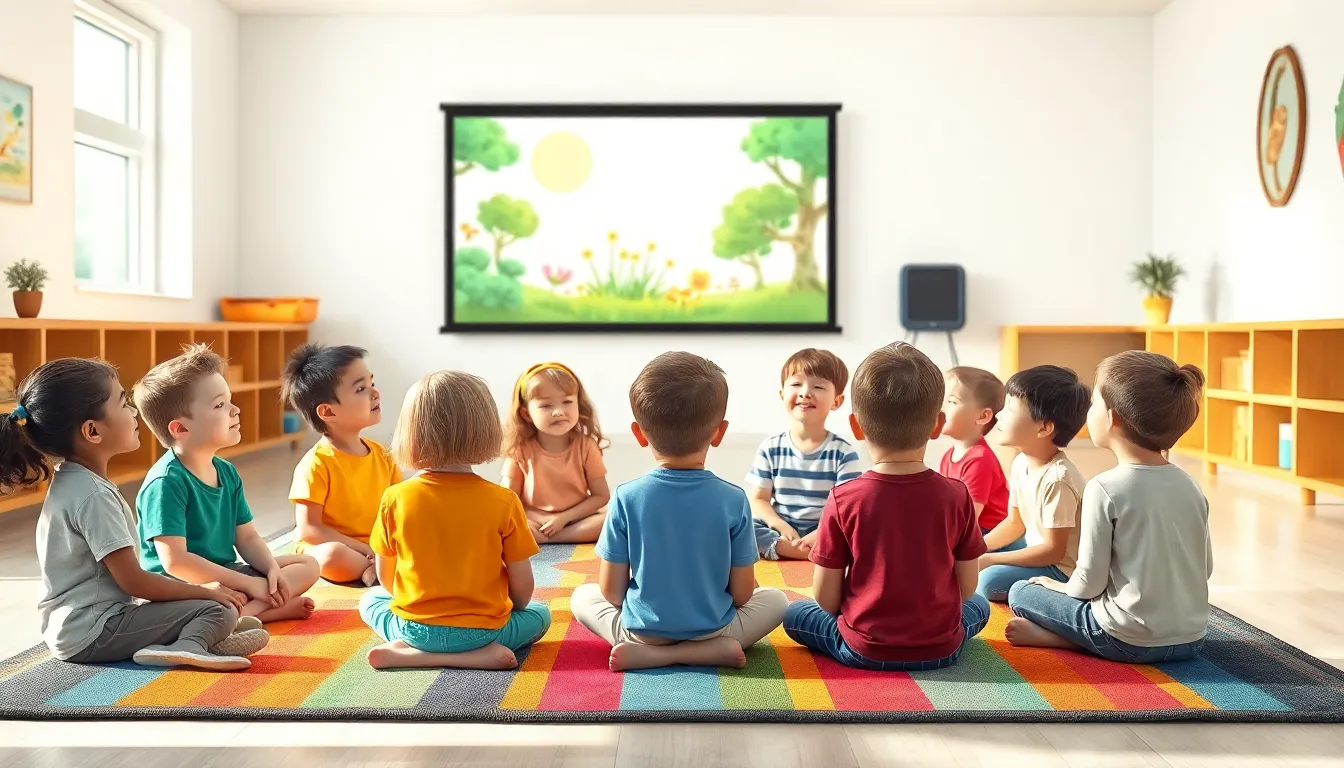In a world buzzing with distractions, teaching kids to be present might feel like a Herculean task. But what if there was a fun and engaging way to introduce them to mindfulness? Enter mindfulness videos for kids—think of them as the superhero capes for little minds, swooping in to save the day from chaos and anxiety.
Mindfulness Video For Kids
Mindfulness represents a state of awareness that involves being present in the moment. Engaging with feelings, thoughts, and surroundings helps children develop this essential skill.
What Is Mindfulness?
Mindfulness involves focusing on the present without judgment. Practicing mindfulness allows children to observe their thoughts and emotions. It encourages awareness of breathing and other sensations. Different techniques, such as guided imagery and body scanning, enable kids to explore mindfulness further. Simple activities can foster this practice, making it accessible and enjoyable for young ones.
Benefits of Mindfulness for Kids
Mindfulness offers numerous benefits for children’s emotional and mental well-being. Studies indicate that mindful kids exhibit reduced anxiety and improved concentration. Regular practice promotes better emotional regulation. Enhanced emotional resilience arises as children learn to cope with challenges effectively. Mindfulness activities encourage social skills and empathy, allowing kids to connect more meaningfully with peers. Integrating mindfulness into daily routines provides lifelong emotional and cognitive advantages.
Overview of Mindfulness Videos for Kids

Mindfulness videos for kids provide engaging ways for young audiences to learn and practice mindfulness. These resources support emotional growth and help children manage daily stresses.
Types of Mindfulness Videos
Various types of mindfulness videos cater to different age groups and needs. Guided meditations encourage relaxation and focus. Story-based animations introduce mindfulness concepts through relatable characters. Short exercises often present quick techniques for calming down, while nature visuals foster a sense of peace. Parents can find content specifically designed for classroom settings, enhancing group mindfulness activities.
Key Features to Look For
When selecting mindfulness videos, consider several key features. Visual quality affects engagement, so look for bright, inviting animations. Narration should be clear, with calming voices that draw in young viewers. Content length matters; shorter videos work better for maintaining attention spans. Check for interactive elements that invite participation, such as breathing exercises or questions. Finally, look for diversity in themes, ensuring different emotions and scenarios are covered.
Review of Popular Mindfulness Videos for Kids
Mindfulness videos for kids engage young audiences by offering interactive and enjoyable techniques for cultivating mindfulness. Here are some notable titles:
Video 1: “Mindful Moments: Breathing Buddies”
This video introduces children to the concept of mindful breathing through colorful animations. Guided by a friendly character, kids learn to focus on their breath, promoting relaxation. Engaging visuals and calming music create an inviting atmosphere. Short, structured practices make it easy for children to integrate mindfulness into their daily routines.
Video 2: “Nature’s Wonders: A Mindful Journey”
In this immersive experience, children explore nature while practicing mindfulness. Each segment features stunning scenes of forests, rivers, and wildlife. Simple narration encourages kids to observe their surroundings, enhancing their awareness of the present moment. This video emphasizes sensory exploration, helping children connect with nature and foster a sense of wonder.
Video 3: “Happy Thoughts: A Guided Adventure”
This video combines storytelling with mindfulness techniques to engage children actively. Kids follow the journey of a character facing challenges and discover tools for managing emotions. Creative storytelling strengthens emotional intelligence while guided practices help them manage stress. Charming animations and relatable scenarios keep children captivated, making mindfulness accessible and fun.
How to Incorporate Mindfulness Videos into Daily Routine
Integrating mindfulness videos into a child’s daily routine encourages a consistent practice that enhances emotional well-being.
Suggested Viewing Times
Morning time creates an excellent opportunity to start the day with mindfulness. Watching a video first thing helps children set a positive tone for the day. Alternatively, midday breaks serve as great moments for calming moments. These mini sessions can relieve stress accumulated during school or activities. Even bedtime provides a peaceful way to wind down, promoting relaxation before sleep. Experimenting with these times helps identify what works best for individual children.
Engaging Activities Post-Viewing
Engaging children in activities after viewing enhances the mindfulness experience. Guided discussions about feelings encourage them to express thoughts and emotions. Additionally, drawing or journaling about the video’s themes can solidify their understanding. Creating simple breathing exercises help them practice techniques learned in the video. Incorporating movement activities like yoga stretches fosters body awareness and calmness. Reinforcing concepts through playful interactions strengthens mindfulness habits in everyday life.
Conclusion
Mindfulness videos for kids serve as powerful tools in nurturing emotional intelligence and resilience. By making mindfulness engaging and accessible, these videos help children navigate their feelings and manage stress effectively. Incorporating mindfulness practices into daily routines not only enhances their emotional well-being but also fosters a sense of calm and focus.
As children explore various mindfulness techniques through captivating visuals and storytelling, they develop essential skills that will benefit them throughout their lives. Embracing these resources can transform the way kids interact with their emotions and surroundings, paving the way for a more mindful future.

